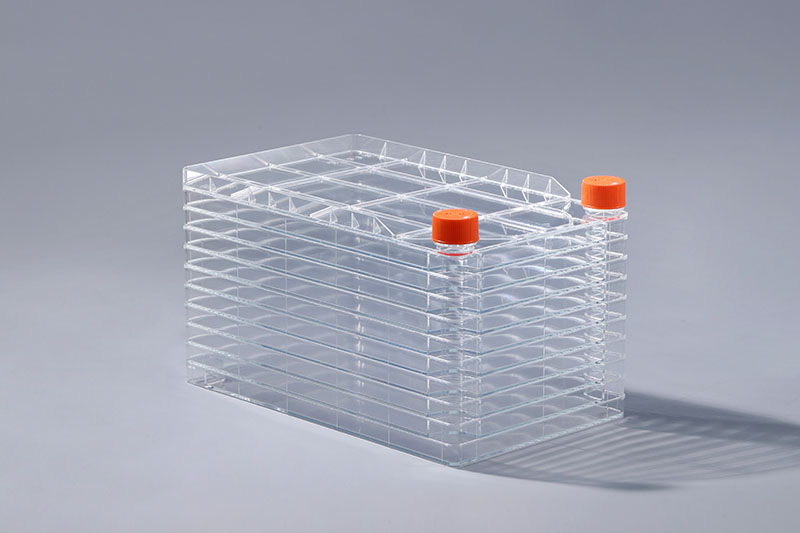जीवन विज्ञान के क्षेत्र के गहन विकास के साथ, बायोफर्मासिटिकल्स, औद्योगिक वैक्सीन उत्पादन और मोनोक्लोनल एंटीबॉडी जैसे कई क्षेत्रों में सेल कल्चर तकनीक का व्यापक रूप से उपयोग किया जाता है। कोशिका वृद्धि के विभिन्न तरीकों के अनुसार, इसे दो श्रेणियों में बांटा गया है: अनुयाई कोशिकाएँ और निलंबन कोशिकाएँ। तो सेल फैक्ट्रियों?
का उपयोग करके कौन से सेल को कल्चर किया जा सकता है सेल फैक्ट्री सेल कल्चर उपभोग्य सामग्रियों की एक बहु-परत संरचना है। सामान्य विशिष्टताओं में 1 परत, 2 परतें, 5 परतें, 10 परतें, 40 परतें आदि शामिल हैं। इसका उपयोग मुख्य रूप से अनुयाई कोशिकाओं की संस्कृति के लिए किया जाता है। अनुयाई कोशिकाओं के विकास में एक समर्थन सतह होनी चाहिए जिसे संलग्न किया जा सकता है, और कोशिकाएं स्वयं द्वारा स्रावित या संस्कृति माध्यम में प्रदान किए गए लगाव कारकों पर भरोसा करके इस सतह पर विकसित और पुन: उत्पन्न हो सकती हैं। कोशिकाओं के संलग्न होने के बाद, वे आम तौर पर कुछ दिनों के भीतर संस्कृति की सतह को कवर करते हैं और घने सेल मोनोलेयर बनाते हैं, जैसे वेरो कोशिकाएं, एचईके 293 कोशिकाएं, सीएआर-टी कोशिकाएं, एमआरसी 5, सीईएफ कोशिकाएं, पोर्सिन वायुकोशीय मैक्रोफेज, मायलोमा कोशिकाएं, डीएफ - 1 सेल, एसटी सेल, पीके15 सेल, मार्क 145 सेल आदि सभी को कल्चर के लिए सेल फैक्ट्री में लगाया गया था। निलंबन कोशिकाएं उन कोशिकाओं को संदर्भित करती हैं जो समर्थन की सतह से स्वतंत्र रूप से बढ़ती हैं और संस्कृति माध्यम में निलंबन में बढ़ती हैं, जैसे लिम्फोसाइट्स।
सेल कारखाने आमतौर पर पॉलीस्टाइनिन कच्चे माल से उत्पन्न होते हैं, और सतह हाइड्रोफोबिक होती है। यदि इसका उपयोग अनुयाई सेल कल्चर के लिए किया जाता है, तो सतह को इसकी हाइड्रोफिलिसिटी बढ़ाने के लिए टीसी के साथ इलाज करने की आवश्यकता होती है, जो सेल अनुयाई विकास के लिए उपयुक्त है।
Cell factories are generally produced from polystyrene raw materials, and the surface is hydrophobic. If it is used for adherent cell culture, the surface needs to be treated with TC to increase its hydrophilicity, which is suitable for cell adherent growth.
The FAI climbed 5.9 percent year-on-year in the first 11 months of 2018, quickening from the 5.7-percent growth in Jan-Oct, the National Bureau of Statistics (NBS) said Friday in an online statement.
The key indicator of investment, dubbed a major growth driver, hit the bottom in August and has since started to rebound steadily.
In the face of emerging economic challenges home and abroad, China has stepped up efforts to stabilize investment, in particular rolling out measures to motivate private investors and channel funds into infrastructure.
Friday's data showed private investment, accounting for more than 60 percent of the total FAI, expanded by a brisk 8.7 percent.
NBS spokesperson Mao Shengyong said funds into weak economic links registered rapid increases as investment in environmental protection and agriculture jumped 42 percent and 12.5 percent respectively, much faster than the average.
In breakdown, investment in high-tech and equipment manufacturing remained vigorous with 16.1-percent and 11.6-percent increases respectively in the first 11 months. Infrastructure investment gained 3.7 percent, staying flat. Investment in property development rose 9.7 percent, also unchanged.
 English
English



















































